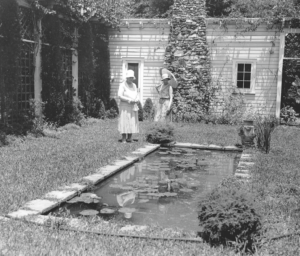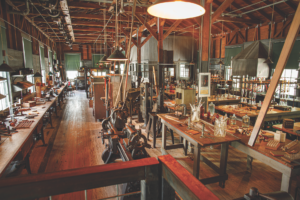The Edison and Ford Winter Estates in Fort Myers is a lot more than light bulbs and Model Ts. The homes and grounds, which were bolstered by a massive restoration effort in the early 2000s, paint a fascinating picture of life in Southwest Florida in the early 20th century.
 Thomas Edison purchased 13.5 acres of waterfront property in 1885 while seeking an escape from the harsh New Jersey winters. Lumber mills weren’t yet available in Fort Myers, so blueprints, based on his own sketches, were sent to a contractor in Maine. Structural larch panels were sent down on a schooner to be assembled on-site. The two original Craftsman-style homes were each about 3,000 square feet, with high pitched roofs and wraparound porches.
Thomas Edison purchased 13.5 acres of waterfront property in 1885 while seeking an escape from the harsh New Jersey winters. Lumber mills weren’t yet available in Fort Myers, so blueprints, based on his own sketches, were sent to a contractor in Maine. Structural larch panels were sent down on a schooner to be assembled on-site. The two original Craftsman-style homes were each about 3,000 square feet, with high pitched roofs and wraparound porches.
Bill Mudgett, of Parker/Mudgett/Smith Architects in Fort Myers, helped develop the master plan for the estate’s restoration in 2003, when after decades of minimal maintenance under city ownership, the walls and floors in Edison’s home were crumbling. Ford’s property, a few yards away, was in better shape, having been built using local pine and cypress, which stand up better to the elements.
Mudgett’s firm, along with a team of historians, curators and restoration contractors, studied archived photos to restore the estates to how they looked in 1929, when all the existing structures were already built.
Although the home was “unassuming,” as Edison’s friend James Newton wrote in his book, Uncommon Friends, the sprawling estate also included a caretaker’s cottage, swimming pool complex and thousands of botanicals. Many of those were planted over the years as part of Edison’s experiments to find alternative rubber sources, as well as plant-based filaments for his light bulbs.
 The Edisons entertained illustrious guests, like President Herbert Hoover, Harvey Firestone, Jay Norwood “Ding” Darling, and the Kellogg and Colgate families. Close friends of the Edisons attended Sunday dinners in the guest house, where entertaining typically took place. Only once each year—on his birthday—would Edison welcome the press to his so-called Seminole Lodge. He’d settle into a wicker chair in the yard to answer questions about his work and his outlook on the nation’s prosperity. Newton noted that in later years, national reporters would flock to Fort Myers for the annual interview.
The Edisons entertained illustrious guests, like President Herbert Hoover, Harvey Firestone, Jay Norwood “Ding” Darling, and the Kellogg and Colgate families. Close friends of the Edisons attended Sunday dinners in the guest house, where entertaining typically took place. Only once each year—on his birthday—would Edison welcome the press to his so-called Seminole Lodge. He’d settle into a wicker chair in the yard to answer questions about his work and his outlook on the nation’s prosperity. Newton noted that in later years, national reporters would flock to Fort Myers for the annual interview.
In 1916, Edison’s friend and fellow inventor Henry Ford purchased the humble bungalow next door. Shrouded by mango trees and oleanders, the property afforded the Fords the privacy they desired, and enabled Henry and his wife to inconspicuously take part in their favorite hobby: bird watching.
Both couples were avid nature lovers. An early sketch made by Edison shows an aerial view of the estate’s acreage neatly divided into parcels. He noted areas where there should be “trees—bushes, etc,” “grass all through,” “flowers,” and “lawn.” The corner of the property near the river indicated Edison’s wish for a section of bananas and a row of bamboo for his light bulb experiments.
When they first moved to Fort Myers, Edison’s wife, Mina, was disappointed to find that “there were no trees, not even a blade of grass—just piles of sand.” But she and her husband helped to cultivate the green cityscapes we see now—Mina as an active member of several garden clubs, and Thomas most notably lining 10 miles of McGregor Boulevard with towering royal palms, which still stand today. In 1933, when Mina was president of the Fruit, Flower and Plant Guild, her and the group’s plan to brighten Tamiami Trail with oleanders was submitted to—and approved by—the State Road Department and Florida’s governor.
 At the estates, guests marveled at the intricacy of the homes and landscape, which continue to symbolize the families’ admiration of the area. Mina seemed to recognize the significance of the estates when she deeded Seminole Lodge to the City of Fort Myers in 1947.
At the estates, guests marveled at the intricacy of the homes and landscape, which continue to symbolize the families’ admiration of the area. Mina seemed to recognize the significance of the estates when she deeded Seminole Lodge to the City of Fort Myers in 1947.
The Edison estate was converted into a museum shortly after, with visitors lining up inside the lab garage—which had become a makeshift ticket office—to get a look at the inventor’s private dwelling.
Ford’s home was added to the museum complex after being purchased by the city in 1988. While the properties were maintained, little work was done on them and by the early 2000s, then-mayor Jim Humphrey stated the “houses were in danger of falling down.” He moved to privatize the estates, transferring the property from the city to the Thomas Edison and Henry Ford Winter Estates, Inc., the nonprofit that still runs the site today.
 In 2003, under the leadership of Chris Pendleton, the former president and CEO of the estates, the organization kicked off the $10 million, multiyear restoration project that expanded the cultural attraction. Pendleton also developed a strong slate of programming, which ensures the site remains relevant with visitors while being a strong anchor for the community.
In 2003, under the leadership of Chris Pendleton, the former president and CEO of the estates, the organization kicked off the $10 million, multiyear restoration project that expanded the cultural attraction. Pendleton also developed a strong slate of programming, which ensures the site remains relevant with visitors while being a strong anchor for the community.
Today, local adults and children participate in dozens of classes hosted through the STEAM (Science, Technology, Engineering, Art and Math) program; the estates’ annual Holiday Nights event draws thousands to stroll the grounds at dusk; and throughout the year, the Estates Garden Shoppe, next to the lab, sells fruit trees, herbs and propagated seeds from the site’s historic trees.
When Mina handed the key to her home to the city, she told those in attendance: “My faith and belief in the sincerity of the people of Fort Myers prompts me to make this sacred spot a gift to you and posterity as a sanctuary and botanical park in the memory of my honored and revered husband. May you find the possession of it as great a blessing as it has ever been to us.”
It’s fair to say we do.






